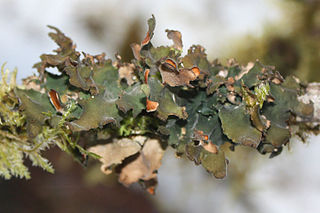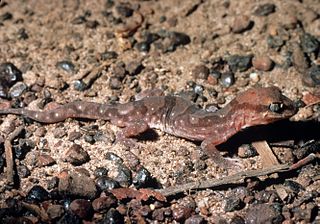
The Strait of Sicily is the strait between Sicily and Tunisia. The strait is about 145 kilometres (90 mi) wide and divides the Tyrrhenian Sea and the western Mediterranean Sea, from the eastern Mediterranean Sea. The maximum depth is 316 meters (1,037 ft).

Precious coral, or red coral, is the common name given to a genus of marine corals, Corallium. The distinguishing characteristic of precious corals is their durable and intensely colored red or pink-orange skeleton, which is used for making jewelry.
The Paraglomerales are a group of exclusively hypogeous (underground) arbuscular mycorrhizal fungi that rarely produce vesicles and reproduce through unpigmented spores. It includes the species Paraglomus brasilianum, Paraglomus laccatum, and Paraglomus occultum.
Platythecium is a genus of lichenized fungi in the family Graphidaceae. It contains an estimated 27 species.
Bulbophyllum occultum is a species of orchid in the genus Bulbophyllum.

Nephroma is a genus of medium to large foliose lichens. The genus has a widespread distribution and contains 36 species. They are sometimes called kidney lichens, named after the characteristic kidney-shaped apothecia that they produce on the lower surface of their lobe tips, which often curl upwards and thus are visible from above. Sterile specimens that do not have apothecia can look somewhat like Melanelia, Peltigera, Platismatia, or Asahinea. Most species grow either on mossy ground or rocks, or on trees.

Coralliidae, also known as precious corals, is a taxonomic family of soft corals belonging to the phylum Cnidaria of the family Scleraxonia. These sessile corals are one of the most dominant members of hard-bottomed benthics environments such as seamounts, canyons and continental shelves. From this coral family results 69 descendants in which each species plays a key role in forming habitats for a variety of marine species. Due to their unique trait of possessing a red calcium carbonate skeleton, these corals can be harvested in order to create handcrafted amulets, jewelry and other valuable artifacts giving rise to its reputed name of "precious corals". Correspondingly, members of this family are vulnerable to the negative impacts of overharvestation imposed by mass coral trade.
Gnomibidion is a genus of beetles in the family Cerambycidae, containing the following species:
Acrolophus occultum is a moth of the family Acrolophidae. It is found in the West Indies.
Lobulicium is a fungal genus in the family Atheliaceae. The genus is monotypic, containing the single species Lobulicium occultum, found in Europe. The fungus produces small, crust-like (resupinate) fruit bodies on decayed wood. Its spores are thin-walled, and have seven lobes.
Gnomibidion occultum is a species of beetle in the family Cerambycidae. It was described by Martins in 1968.

Lucasium is a genus of lizards, sometimes called ground geckos, in the family Diplodactylidae. The genus is endemic to Australia, and it includes 14 species.

The Alligator River gecko is a gecko endemic to Australia.
Euzetia lamothei is a flatworm which parasitizes the gills of the cownose ray. It is named after Dr. Marcos Rafael Lamothe Argumedo, a professor at Universidad Nacional Autónoma de México who has done research on Monogeneans. The species averages 405 micrometers long by 178 micrometers wide. It can be distinguished from its closest relative, Euzetia occultum, based on size and the morphology of the reproductive organs.
Euzetia is the only genus in the subfamily Euzetiinae, a group of flatworms which parasitize Elasmobranchs. As of 2008, only two species have been described in the genus, however others may remain undescribed. The genus consists of Euzetia occultum, which is the type species for the genus, and Euzetia lamothei, which was described in 2008. E. occultum parasitizes the Australian cownose ray, Rhinoptera neglecta, while E. lamothei parasitizes a different species in the same genus, the cownose ray, Rhinoptera bonasus. Both species inhabit the gills of their respective hosts. The genus is differentiated from other genera based on the morphology of the haptor, and is named for the French parasitologist Louis Euzet.
Euzetia occultum is a species of flatworm which parasitizes the gills of the Australian cownose ray and is the type species for its genus. It can be distinguished from Euzetia lamothei based on its overall size and reproductive morphology.
Tritonia coralliumrubri is a species of dendronotid nudibranch. It is a marine gastropod mollusc in the family Tritoniidae. It feeds on the octocoral Corallium rubrum, the red coral.
Dactylosporium is a genus of fungi belonging to the subdivision Pezizomycotina, unknown family.
Erianthemum is a genus of flowering plants belonging to the family Loranthaceae.






